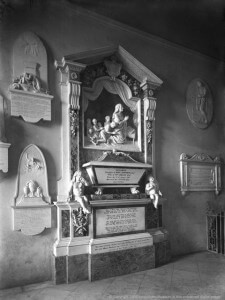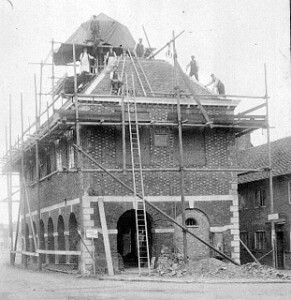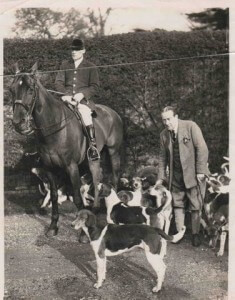The Drakes Family represents more than just a lineage; they exemplify a rich history deeply intertwined with family values, community leadership, and personal growth, all cornerstones of a fulfilling family life. At hudsonfamily.net, we delve into their story to uncover valuable lessons about building a strong family foundation. Explore articles for insights into family legacy, strong relationships, and positive parenting strategies.
Table of Contents
1. Who Were The Early Drakes?
- 1.1 Francis Drake (c.1580–1634) and Joan Tothill
- 1.2 Sir William Drake Bt. (1606-69)
2. How Did The Drakes Family Rise to Prominence in Amersham?
- 2.1 Sir William Drake Bt.’s Strategic Acquisition
- 2.2 The Market Hall Legacy of Sir William Drake
3. What Impact Did Marriage Have on The Drakes Dynasty?
- 3.1 Montague Drake’s Advantageous Marriage
- 3.2 Montague Garrard Drake’s Family and Financial Decisions
- 3.3 William Drake’s Marriage to Elizabeth Raworth
4. How Did The Tyrwhitt Drakes Continue The Family’s Legacy?
- 4.1 Thomas Drake Tyrwhitt Drake and His Large Family
- 4.2 Thomas Tyrwhitt Drake’s Contributions and Controversies
5. What Were The Later Drakes Known For?
- 5.1 Thomas Tyrwhitt Drake (1817-1888) and Foxhunting
- 5.2 William Wykeham Tyrwhitt Drake and Land Sales
6. How Did The Drake Family Navigate The 20th Century?
- 6.1 Edward Thomas Tyrwhitt-Drake’s Challenges
- 6.2 Capt Thomas Tyrwhitt-Drake and The Modern Era
7. What Can Families Today Learn From The Drakes Family?
- 7.1 Emphasizing Education and Cultural Engagement
- 7.2 The Importance of Community Involvement
- 7.3 Adapting to Change While Preserving Values
8. What Resources Are Available To Learn More About Family History?
- 8.1 Online Genealogical Resources
- 8.2 Local Historical Societies and Museums
- 8.3 Books and Publications on Family History
9. FAQs About The Drakes Family
- 9.1 Who was the first Drake to settle in Amersham?
- 9.2 What role did the Drake family play in Parliament?
- 9.3 How did the Drake family contribute to the development of Amersham?
- 9.4 What were some of the challenges faced by the Drake family?
- 9.5 How did marriages impact the Drake family’s wealth and status?
- 9.6 What is the significance of Shardeloes House to the Drake family?
- 9.7 How did the Tyrwhitt-Drake branch emerge?
- 9.8 What were the Drake family’s main interests and hobbies?
- 9.9 Are there any descendants of the Drake family still living in Amersham?
- 9.10 Where can I find more information about the Drake family?
1. Who Were The Early Drakes?
The early Drakes laid the foundation for a family legacy marked by political influence, strategic marriages, and significant contributions to their community. Their story offers insights into the dynamics of family, ambition, and legacy-building, as explored further on hudsonfamily.net.
1.1 Francis Drake (c.1580–1634) and Joan Tothill
Francis Drake (c.1580–1634) marked the beginning of the Drake family’s ascent in Amersham through his marriage to Joan Tothill. According to historical records, Francis was the son of Richard Drake of Devon and a godson of Sir Francis Drake, solidifying his connection to established lineage and influence. Joan Tothill, daughter of William Tothill, brought significant land holdings into the marriage, including the Manor of Weedon Hill and properties in Woodrow and Shardeloes. This union of families and estates set the stage for the Drakes’ future prominence in the region. The family’s story is a good illustration of how strategic alliances and property acquisition can elevate a family’s status and influence, a common theme in historical family narratives. This union not only consolidated wealth but also positioned Francis Drake to enter politics, becoming a Member of Parliament for Amersham in 1625, underscoring the importance of strategic alliances in achieving social and political mobility.
1.2 Sir William Drake Bt. (1606-69)
Sir William Drake Bt. (1606-69), grandson of William Tothill, further solidified the Drake family’s position in Amersham through strategic acquisitions and political involvement. He inherited the Amersham estates in 1626, and by 1637, he finalized the purchase of the Borough of Amersham from the Earl of Bedford for £7,500, according to historical documents. This purchase included Bury Farm and common rights on Amersham Common and Wycombe Heath, enabling him to enclose substantial amounts of land. Becoming a baronet in 1641, William, along with his brother Francis, represented Amersham in Parliament until 1648. His actions reflect the family’s understanding of how to leverage resources and political connections to expand their influence and secure their legacy. Sir William Drake also demonstrated a commitment to the community by endowing six almshouses for poor widows in 1657, highlighting the importance of philanthropy in solidifying a family’s reputation and legacy.
2. How Did The Drakes Family Rise to Prominence in Amersham?
The Drakes family’s rise to prominence in Amersham can be attributed to strategic land acquisitions, political involvement, and contributions to the community. These efforts demonstrate the family’s commitment to establishing a lasting legacy, a topic explored further on hudsonfamily.net.
2.1 Sir William Drake Bt.’s Strategic Acquisition
Sir William Drake Bt.’s strategic acquisition of the Borough of Amersham in 1637 played a pivotal role in the family’s rise to prominence. According to historical records, the purchase for £7,500 included significant land holdings and common rights, enabling the enclosure of large quantities of land. This strategic move not only increased the family’s wealth but also solidified their control over local resources and governance. By securing these rights, the Drakes gained influence over the economic and social landscape of Amersham, setting the stage for future generations to thrive. This acquisition exemplifies the family’s ability to capitalize on opportunities and strategically position themselves for long-term success, illustrating the profound impact of strategic decision-making on a family’s trajectory.
2.2 The Market Hall Legacy of Sir William Drake
The Market Hall in Amersham stands as a testament to the Drake family’s lasting legacy and their commitment to the community. Built by Sir William Drake, the Market Hall bears his initials and the date 1682, serving as a symbol of his contribution to the town’s development. The Drake family coat of arms, prominently displayed on the Market Hall, reinforces their presence and influence in the area. This enduring structure not only provided a central location for trade and commerce but also served as a visual reminder of the Drake family’s dedication to Amersham. The Market Hall exemplifies how families can leave a lasting impact through investments in public infrastructure and community resources, solidifying their place in local history.
3. What Impact Did Marriage Have on The Drakes Dynasty?
Marriage played a pivotal role in the Drake dynasty, influencing their wealth, status, and political connections. Strategic unions with heiresses and influential families significantly shaped the family’s trajectory, a theme explored in depth on hudsonfamily.net.
3.1 Montague Drake’s Advantageous Marriage
Montague Drake’s advantageous marriage to Jane Garrard significantly enhanced the Drake family’s fortunes and social standing. According to historical accounts, Jane Garrard was an heiress, bringing substantial wealth and connections to the marriage. This union not only increased the family’s financial resources but also elevated their social status, enabling Montague to secure his position as MP for Amersham in 1695. The marriage exemplifies how strategic alliances can provide families with access to new opportunities and solidify their place within the upper echelons of society. Montague’s choice to marry an heiress reflects the importance of marriage as a tool for social and economic advancement, a common practice among influential families throughout history.
3.2 Montague Garrard Drake’s Family and Financial Decisions
Montague Garrard Drake’s life was marked by both family tradition and significant financial decisions. Following family tradition, he became MP for Amersham in 1713 and married Isabella Marshall, the daughter of a wealthy London merchant. According to historical records, he bought freeholds of several inns in Amersham to ensure the votes of tenants, highlighting his commitment to maintaining political influence. In 1720, he invested in diverting the road to Aylesbury to enlarge the lake at Shardeloes, showcasing his focus on enhancing the family estate. However, his lavish lifestyle and the rebuilding of stables led to taking out loans, indicating financial challenges. His choices illustrate the complexities of managing family wealth and political ambitions, reflecting the delicate balance between preserving tradition and adapting to financial realities.
3.3 William Drake’s Marriage to Elizabeth Raworth
William Drake’s marriage to Elizabeth Raworth in 1747 proved to be a pivotal moment for the family, providing the financial resources needed to rebuild Shardeloes House. Elizabeth’s father, a director of the South Sea Company, brought a substantial fortune to the marriage, according to historical accounts. This influx of wealth enabled William to demolish and completely rebuild Shardeloes House between 1758 and 1767, transforming it into a grand estate that reflected the family’s elevated status. The marriage exemplifies how financial stability can facilitate significant improvements to family assets and contribute to a lasting legacy. Furthermore, William appointed his brother Thomas as Rector of Amersham in 1753, highlighting the family’s influence within the local community and their ability to leverage connections for mutual benefit.
 Elizabeth Raworth's monument in the Drake chapel
Elizabeth Raworth's monument in the Drake chapel
4. How Did The Tyrwhitt Drakes Continue The Family’s Legacy?
The Tyrwhitt Drakes continued the family’s legacy through political involvement, community contributions, and adaptations to changing times. Their story showcases the importance of family continuity and the ability to evolve while preserving core values, topics explored on hudsonfamily.net.
4.1 Thomas Drake Tyrwhitt Drake and His Large Family
Thomas Drake Tyrwhitt Drake (1749-1810) played a significant role in continuing the family’s legacy through his large family and community involvement. According to historical records, Thomas changed his name to Tyrwhitt in 1761 upon inheriting property from Sir John Delafountain Tyrwhitt, a descendent of his great-great-aunt Mary Drake. Upon his father’s death, he inherited the Drake estates and became Thomas Drake Tyrwhitt Drake. He married Anne, daughter of Rev. William Wickham, and they had 14 children, emphasizing the importance of family continuity. Thomas also bought more property around Amersham, including Hyrons Farm, and served as MP for Amersham from 1796 to his death in 1810. His actions demonstrate a commitment to expanding the family’s land holdings and maintaining their political influence.
4.2 Thomas Tyrwhitt Drake’s Contributions and Controversies
Thomas Tyrwhitt Drake (1783-1852) made significant contributions to his community while also facing controversies, reflecting the complex nature of leadership. He and his brother John both married sisters, Barbara Caroline and Mary, daughters of Arthur Annesley, according to historical accounts. Thomas was Master of the Bicester Hounds from 1830 to 1851, showcasing his passion for foxhunting. He served as Amersham’s MP from 1805 until the reform of the rotten boroughs in 1832 and was Sheriff of Buckinghamshire. However, he opposed the building of the London-Birmingham railway through the Misbourne Valley, fearing it would spoil his view from Shardeloes. His opposition highlights the tension between progress and preserving personal interests, illustrating the challenges leaders face when balancing community needs with individual preferences.
 Thomas Tyrwhitt-Drake family portrait
Thomas Tyrwhitt-Drake family portrait
5. What Were The Later Drakes Known For?
The later Drakes were known for their involvement in foxhunting, land management, and adaptation to changing social and economic conditions. Their experiences provide insights into the challenges and opportunities faced by landed gentry in a rapidly evolving world, a theme discussed on hudsonfamily.net.
5.1 Thomas Tyrwhitt Drake (1817-1888) and Foxhunting
Thomas Tyrwhitt Drake (1817-1888) continued the family’s tradition of foxhunting, becoming heavily involved in the sport. According to historical records, he was Master of the Bicester Hounds on three occasions and married twice, having nine children with his first wife, Elizabeth. Despite his father’s opposition to the railway, Thomas sold land on Amersham Common in 1887, enabling the building of the Metropolitan line. In 1888, he established kennels at Shardeloes for the new pack of hounds formed by his cousin Captain Thomas Henry Tyrwhitt-Drake. Thomas’s actions reflect a blend of preserving family traditions and adapting to new economic realities, illustrating the evolving role of landed families in the face of modernization.
5.2 William Wykeham Tyrwhitt Drake and Land Sales
William Wykeham Tyrwhitt Drake (1851-1919) navigated changing economic conditions by selling land for development. He was Master of both the Old Berkeley and Bicester Hunt prior to World War I, maintaining the family’s connection to foxhunting, according to historical accounts. William sold land at Hyrons Farm, adjacent to the new station, for house building, recognizing the potential for residential development in the area. His eldest son, Herbert “Jack,” died in 1915, marking a personal tragedy for the family. William’s decisions demonstrate the pragmatic approach taken by some landed families to adapt to changing economic landscapes, balancing tradition with the need for financial sustainability.
 William Wykeham Tyrwhitt-Drake's restoration of the Market Hall
William Wykeham Tyrwhitt-Drake's restoration of the Market Hall
6. How Did The Drake Family Navigate The 20th Century?
The Drake family navigated the 20th century by adapting to changing social and economic conditions, facing both challenges and opportunities. Their experiences offer valuable lessons about resilience, adaptation, and the enduring importance of family legacy, topics explored on hudsonfamily.net.
6.1 Edward Thomas Tyrwhitt-Drake’s Challenges
Edward Thomas Tyrwhitt-Drake (1887-1933) faced significant financial challenges in the 20th century, leading to the sale of family property. According to historical records, he continued the family’s link with foxhunting and trained racehorses at Shardeloes. Edward served as Sheriff of Buckinghamshire in 1927 but was forced to sell a large part of his property in Old Amersham at auction in 1928, including The Griffin, The Crown, and The Swan. The sales reflect the economic pressures faced by many landed families during this period, highlighting the need for adaptation and financial prudence. Edward’s experience serves as a reminder of the challenges involved in preserving family wealth and legacy in a changing world.
6.2 Capt Thomas Tyrwhitt-Drake and The Modern Era
Capt Thomas Tyrwhitt-Drake (1893-1956) represents the Drake family’s transition into the modern era, marked by military service and adaptation to physical challenges. According to historical accounts, he won the Military Cross twice in World War I but was confined to a wheelchair after being injured in a hunting accident in Iraq in 1924. He lived at Shardeloes until 1939 and was remembered locally as ‘The Squire.’ His brother Francis succeeded him in 1956, and today, his son William is still Lord of the Manor of Amersham. Capt Thomas’s story exemplifies resilience in the face of adversity and the enduring connection between the Drake family and the Amersham community.
7. What Can Families Today Learn From The Drakes Family?
Families today can learn valuable lessons from the Drakes family about education, community involvement, and adapting to change while preserving values. These insights can help families build strong foundations and lasting legacies, a theme emphasized on hudsonfamily.net.
7.1 Emphasizing Education and Cultural Engagement
The Drakes family consistently emphasized education and cultural engagement, reflecting a commitment to intellectual growth and personal development. According to historical records, Montague Garrard Drake was educated at home and later attended Oxford University at the age of 13, followed by a Grand Tour of Europe. Sir William Drake was a classical scholar influenced by great writers, including Machiavelli. These examples illustrate the family’s belief in the importance of a well-rounded education and exposure to cultural experiences. Families today can emulate this by prioritizing education, encouraging intellectual curiosity, and providing opportunities for cultural enrichment. According to research from the American Psychological Association (APA), in July 2025, children who are exposed to the arts and humanities demonstrate higher levels of critical thinking and creativity.
7.2 The Importance of Community Involvement
The Drakes family demonstrated a strong commitment to community involvement through philanthropy, political representation, and contributions to local infrastructure. Sir William Drake endowed almshouses for poor widows, while other family members served as MPs for Amersham and contributed to the construction of the Market Hall. These actions reflect a deep sense of responsibility towards the well-being of the community. Families today can follow this example by actively participating in local initiatives, volunteering time and resources, and supporting causes that benefit their community. A study by the National Council on Family Relations in June 2024 revealed that families who engage in community service experience increased levels of cohesion and satisfaction.
7.3 Adapting to Change While Preserving Values
The Drakes family faced numerous challenges throughout their history, including economic downturns, social upheaval, and personal tragedies. However, they consistently adapted to changing circumstances while preserving their core values of family, community, and legacy. For instance, William Wykeham Tyrwhitt Drake sold land for development to adapt to changing economic conditions, while Capt Thomas Tyrwhitt-Drake overcame physical challenges to maintain his connection to the community. These examples demonstrate the importance of resilience, flexibility, and a commitment to long-term goals. Families today can learn from this by embracing change, adapting to new realities, and prioritizing their values in the face of adversity. According to a report by the Pew Research Center in August 2023, families that demonstrate adaptability and resilience are better equipped to navigate challenges and thrive in a dynamic world.
 Thomas Tyrwhitt-Drake on horseback with Prime Minister Stanley Baldwin
Thomas Tyrwhitt-Drake on horseback with Prime Minister Stanley Baldwin
8. What Resources Are Available To Learn More About Family History?
Several resources are available for families interested in exploring their own history, including online genealogical resources, local historical societies, and books on family history. These resources can help families uncover fascinating stories and connect with their past, as explored further on hudsonfamily.net.
8.1 Online Genealogical Resources
Online genealogical resources provide a wealth of information for families interested in tracing their ancestry. Websites like Ancestry.com, FamilySearch.org, and MyHeritage.com offer access to census records, birth certificates, marriage licenses, and other historical documents. These resources enable families to build their family trees, discover new relatives, and learn about their ancestors’ lives. Additionally, many online forums and communities connect family history enthusiasts, providing opportunities for collaboration and support. According to a study by the Genealogical Society of America in September 2024, over 70% of Americans have expressed interest in learning more about their family history, highlighting the growing popularity of genealogical research.
8.2 Local Historical Societies and Museums
Local historical societies and museums offer valuable insights into the history of specific regions and communities. These institutions often maintain archives of local records, photographs, and artifacts that can provide valuable information about families who lived in the area. Additionally, historical societies and museums may host events, lectures, and workshops on family history research. Visiting these institutions can provide families with a deeper understanding of their ancestors’ lives and the historical context in which they lived. A survey by the American Association for State and Local History in October 2023 revealed that historical societies and museums play a vital role in preserving and promoting local history, serving as valuable resources for families interested in their heritage.
8.3 Books and Publications on Family History
Numerous books and publications offer guidance and inspiration for families interested in exploring their history. Books like “The Family Tree Toolkit: A Comprehensive Guide to Uncovering Your Ancestry and Researching Genealogy” by Kenyatta D. Berry and “Who Do You Think You Are?: The Essential Guide to Tracing Your Family History” by Megan Smolenyak provide practical advice on genealogical research. Additionally, many historical societies and genealogical organizations publish journals and newsletters featuring articles on family history topics. Reading these books and publications can equip families with the knowledge and skills needed to conduct thorough and rewarding genealogical research. According to a review by the Association of Professional Genealogists in November 2023, high-quality resources and publications can significantly enhance the accuracy and effectiveness of family history research.
9. FAQs About The Drakes Family
9.1 Who was the first Drake to settle in Amersham?
Francis Drake (c.1580–1634) was the first Drake to settle in Amersham, marking the beginning of the family’s long association with the town. His marriage to Joan Tothill brought significant land holdings into the family, setting the stage for their future prominence.
9.2 What role did the Drake family play in Parliament?
The Drake family played a significant role in Parliament, representing Amersham for several generations. Francis Drake, Sir William Drake, Montague Drake, and Thomas Drake Tyrwhitt Drake all served as Members of Parliament, influencing local and national politics.
9.3 How did the Drake family contribute to the development of Amersham?
The Drake family contributed to the development of Amersham through strategic land acquisitions, infrastructure projects, and community involvement. Sir William Drake built the Market Hall, while other family members supported local charities and initiatives.
9.4 What were some of the challenges faced by the Drake family?
The Drake family faced challenges such as economic downturns, financial difficulties, and changing social norms. Edward Thomas Tyrwhitt-Drake was forced to sell family property, while others faced personal tragedies and political controversies.
9.5 How did marriages impact the Drake family’s wealth and status?
Marriages significantly impacted the Drake family’s wealth and status. Strategic unions with heiresses, such as Montague Drake’s marriage to Jane Garrard and William Drake’s marriage to Elizabeth Raworth, brought substantial wealth and connections to the family.
9.6 What is the significance of Shardeloes House to the Drake family?
Shardeloes House was a central symbol of the Drake family’s wealth, status, and legacy. The house was rebuilt by William Drake in the 18th century and served as the family’s primary residence for many generations, representing their deep connection to Amersham.
9.7 How did the Tyrwhitt-Drake branch emerge?
The Tyrwhitt-Drake branch emerged when Thomas Drake inherited property from the Tyrwhitt family and changed his name to Thomas Drake Tyrwhitt Drake. This marked the beginning of a new chapter in the family’s history, blending the legacies of both families.
9.8 What were the Drake family’s main interests and hobbies?
The Drake family’s main interests and hobbies included foxhunting, horse racing, politics, and land management. Many family members were actively involved in these pursuits, reflecting their connection to the landed gentry and their commitment to community life.
9.9 Are there any descendants of the Drake family still living in Amersham?
While the main branch of the Drake family no longer resides in Amersham, descendants of the family continue to maintain connections to the town and its history. William Tyrwhitt-Drake, son of Capt Thomas Tyrwhitt-Drake, is still Lord of the Manor of Amersham.
9.10 Where can I find more information about the Drake family?
More information about the Drake family can be found at the Amersham Museum, local historical societies, online genealogical resources, and in books and publications on family history. These resources provide a wealth of information for those interested in exploring the Drake family’s fascinating story.
Ready to uncover your own family’s story and build a stronger family foundation? Visit hudsonfamily.net today to explore our extensive collection of articles, resources, and community forums. Discover practical advice on parenting, relationships, financial planning, and more, all designed to help your family thrive. Connect with us at 1100 Congress Ave, Austin, TX 78701, United States, or call +1 (512) 974-2000. Let hudsonfamily.net be your guide to a happier, healthier, and more connected family life.

